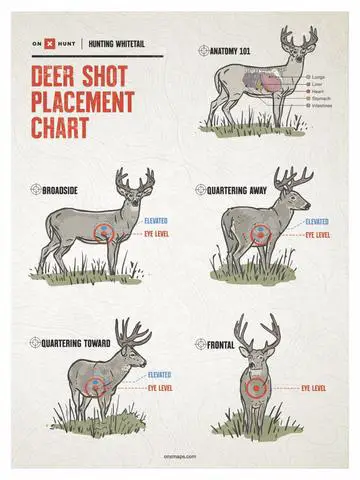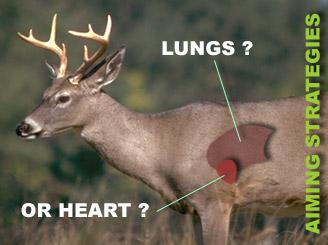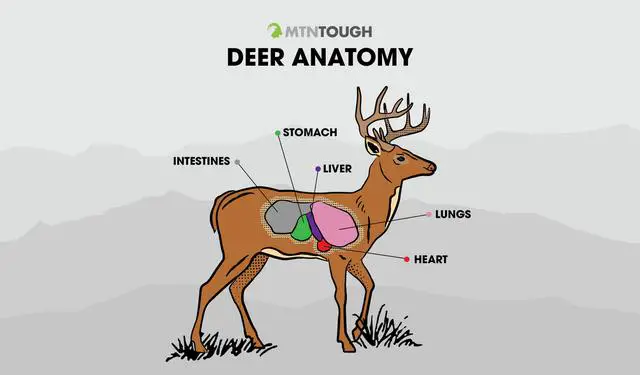When a deer is shot directly in the heart, it can have dramatic and immediate consequences. The vital organ’s destruction results in rapid incapacitation and often leads to a quick and humane death for the animal. Understanding the implications of such a shot is crucial for hunters, as it ensures an ethical and efficient approach to harvesting game.
1. Understanding the Consequences: What Happens When a Deer is Shot in the Heart?

When a deer is shot in the heart, it will experience rapid blood loss, leading to its quick demise. The heart is a vital organ responsible for pumping oxygenated blood throughout the body. When either the upper chambers (atria) or lower chambers (ventricles) of the heart are hit, the deer bleeds out rapidly. This results in a swift and humane kill.
Consequences of Shooting a Deer in the Heart:
– Rapid blood loss: A shot to the heart causes significant bleeding, leading to a quick death for the deer.
– Immediate incapacitation: The deer’s ability to continue moving or fleeing is greatly impaired when its heart is hit.
– Humane kill: Shooting a deer in the heart ensures that it does not suffer unnecessarily and minimizes any potential pain or distress.
It’s important for hunters to aim accurately and ethically to ensure a clean kill and minimize any unnecessary suffering for the animal. By understanding where the deer’s vital organs are located and practicing proper shot placement, hunters can increase their chances of hitting the heart effectively.
2. The Lethal Impact: Exploring the Effects of Shooting a Deer in the Heart

Shooting a deer in the heart is considered one of the most lethal shots a hunter can make. When the bullet or arrow hits either the atria (upper chambers) or ventricles (lower chambers) of the heart, it causes rapid bleeding, leading to a quick and humane kill. The deer’s cardiovascular system is vital for delivering oxygen and nutrients to its body, so targeting its heart disrupts this essential function.
A deer’s heart is located directly in line with the middle of its front leg. The top of the heart sits at the midpoint between its back and belly. By aiming at this specific area, hunters increase their chances of hitting the heart accurately. A shot to the heart ensures that blood loss occurs rapidly, incapacitating the deer swiftly.
When a deer is shot in the heart, it may take only seconds for it to collapse and expire. This quick kill minimizes suffering and allows for an ethical harvest. It also reduces the risk of tracking wounded game over long distances.
In addition to targeting the heart, hitting both lungs is also highly effective when shooting a deer. The lungs fill most of the chest cavity, providing a larger target area than just aiming for the heart alone. Hitting both lungs increases blood loss and further incapacitates the animal.
Overall, shooting a deer in the heart results in a swift and humane kill due to rapid bleeding and disruption of its cardiovascular system. Proper shot placement is crucial for ethical hunting practices and ensuring successful recovery of downed game animals.
3. Anatomy Matters: The Outcome of a Heart Shot on a Deer

A heart shot on a deer is considered the most effective and quickest way to kill the animal. When either the upper chambers (atria) or lower chambers (ventricles) of the heart are hit, the deer bleeds out rapidly, leading to a swift death. The heart is located directly in line with the middle of the deer’s front leg, with the top of the heart sitting at the midpoint between its back and belly.
The Importance of Hitting Vital Organs
Hitting vital organs such as the heart and lungs is crucial for ethical hunting and ensuring a quick kill. A deer has a left lung and a right lung, with its heart positioned between them. The majority of both lungs are set slightly behind the heart and behind its front shoulders. As the lungs fill most of the chest cavity, they provide a larger target area compared to just aiming for the heart.
The Role of Liver Shots
The liver is located further back on a deer, situated between its lungs and stomach and right behind its diaphragm. While a liver shot is fatal, it takes longer for the deer to expire compared to a heart or lung shot. This is because blood loss from the liver is slower than from other vital organs. Liver shots produce dark red or maroon blood with a watery consistency.
Considerations for Smaller Deer
It’s important to note that smaller deer can have vital organs that are half the size of those in mature bucks. Therefore, when shooting at young bucks or does, your margin of error is reduced by 50 percent. Understanding this size difference will help ensure accurate shot placement.
The Best Shot Placement for Different Angles
When it comes to shot placement, different angles require specific aiming points. A broadside shot, where the deer is facing directly towards you, provides an unobstructed path to the heart and both lungs. The best aim for a broadside shot is directly in line with the front leg, between the halfway and lower one-third mark between the bottom of the chest and the top of the back.
For a quartering-away shot, where the deer is at an angle away from you, it’s important to aim further back than its front shoulder. Aiming at the opposite-side shoulder ensures that your arrow or bullet exits where you want it to.
On the other hand, a quartering-toward shot presents greater risks due to potential damage to the front shoulder meat and guts. If this is your only option, aim at the front side of the near shoulder, envisioning your shot exiting at the middle or back of the opposite ribcage.
Frontal shots are ill-advised as they have a smaller target area and involve more bone and fatty tissue. However, if you decide to take a frontal shot, aim high and in the middle to avoid as much bone as possible.
Other Shots Not Recommended
There are other angles and shots that are not recommended for ethical hunting. These include head/neck shots and straight-away shots where the deer is walking or running away from you. Additionally, taking a straight-down shot when in a treestand provides a small target area but may be taken if certain conditions are met.
Understanding deer anatomy and practicing shot placement from different angles will greatly improve your chances of making an ethical kill while hunting with a rifle or bow.
4. Quick Kill or Prolonged Death? The Importance of Hitting the Heart in Deer Hunting

When it comes to deer hunting, hitting the heart is crucial for a quick and ethical kill. The heart shot results in rapid bleeding, leading to a swift death for the animal. Understanding the anatomy of a deer and knowing where its vital organs are located can greatly improve your shot placement.
A deer’s heart is situated directly in line with the middle of its front leg, with the top of the heart positioned at the midpoint between its back and belly. Aiming at this area ensures that your shot hits the heart, causing significant damage and quick expiration.
In addition to the heart, a deer has two lungs located slightly behind and beneath it. The lungs occupy most of the chest cavity, providing a larger target area than just aiming for the heart alone. Hitting both lungs guarantees a lethal shot and increases your chances of recovering the downed animal.
It’s important to note that smaller deer, such as young bucks or does, have vital organs that are half the size of mature bucks. This means that when shooting at smaller deer, your margin of error is significantly reduced by 50 percent.
Taking a broadside shot on a deer is considered ideal as it provides an unobstructed path to both the heart and lungs. Aim directly in line with the front leg, between the halfway and lower one-third mark between the bottom of the chest and top of the back. This will ensure that your shot lands in the meaty area of the heart.
While quartering-away shots are also effective, it’s important to aim further back than you would for a broadside shot. A good rule of thumb is to aim at the opposite-side shoulder where you want your arrow or bullet to exit. This ensures proper penetration through vital organs while avoiding obstructions like bones.
On the other hand, quartering-toward shots and frontal shots are not recommended due to the risk of hitting bones and fatty tissues. These shots can result in poor penetration and limited damage to vital organs, potentially leading to prolonged suffering for the deer.
For hunters in treestands, shot placement can be affected by the height of the stand. Higher treestands make it more challenging to hit vital organs as the deer’s backbone shields them. Adjustments should be made to aim further back on quartering-away shots and more in front of the near shoulder on quartering-toward shots.
To ensure successful shot placement, regular practice from a treestand is essential. Using a rangefinder with angle compensation can help determine the correct shooting distance, considering the vertical height difference between the hunter and the animal.
In conclusion, understanding where to shoot a deer is crucial for ethical hunting and ensuring a quick kill. Targeting the heart and lungs provides the best chance of a clean kill, while avoiding unnecessary suffering for the animal. Regular practice and knowledge of shot placement angles will greatly improve your hunting success.
5. Shot Placement Secrets: Unveiling the Results of Shooting a Deer in the Heart
Shooting a deer in the heart is considered one of the most effective and ethical ways to ensure a quick kill. When either the atria or ventricles of the heart are hit, the deer bleeds out rapidly, leading to a swift demise. The heart is located directly in line with the middle of the deer’s front leg, with the top of the heart sitting at the midpoint between its back and belly.
Aiming for the heart provides a larger target area compared to other vital organs, such as the lungs or liver. This increases the chances of hitting a vital organ and ensuring a clean kill. Additionally, hitting both lungs along with the heart can be achieved with a well-placed shot on a broadside deer.
However, it is important to note that smaller deer, such as young bucks or does, may have vital organs that are half the size of those in mature bucks. This means that when shooting at smaller deer, hunters must be more precise and reduce their margin of error by 50 percent.
In summary, aiming for a deer’s heart is crucial for an ethical kill and quick recovery. Understanding where exactly it is located within its chest cavity allows hunters to make accurate shots and minimize suffering for the animal.
6. Ethical Hunting Guide: What to Expect When You Shoot a Deer in the Heart
Shooting a deer in the heart is one of the most effective and ethical ways to kill the animal quickly. When you hit the heart, the deer will bleed out rapidly, leading to a swift and humane death. However, it’s important to understand what to expect when shooting a deer in the heart.
1. Quick Death
When you shoot a deer in the heart, it will typically result in an immediate drop or collapse of the animal. The rapid blood loss from hitting either the upper chambers (atria) or lower chambers (ventricles) of the heart will cause quick incapacitation and death. This ensures minimal suffering for the animal.
2. Blood Trail
A heart shot on a deer will often produce a significant blood trail, making it easier for hunters to track and recover their downed animal. The blood will be bright red and have a watery consistency, indicating a successful shot placement.
3. Limited Movement
After being shot in the heart, a deer may still exhibit some involuntary movements such as kicking or twitching due to nerve reflexes. However, these movements are not indicative of life or consciousness and are merely residual effects.
4. Field Dressing Considerations
When field dressing a deer that has been shot in the heart, it’s important to be cautious as there may be substantial blood pooling around this vital organ. Take care not to puncture or contaminate any other organs while removing them during field dressing.
In conclusion, shooting a deer in the heart is an ethical way to ensure quick and humane killing during hunting. Understanding what to expect when aiming for this vital organ can help hunters make accurate shots and efficiently recover their downed animals. Remember to always prioritize ethical hunting practices and respect for the animal’s life.
In conclusion, if a deer is shot in the heart, it will likely result in rapid death due to severe internal damage and blood loss. This vital organ’s destruction disables the deer’s ability to pump oxygenated blood, causing a swift demise. Proper aiming and ethical hunting practices are crucial to ensure humane kills and prevent unnecessary suffering.











































